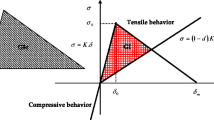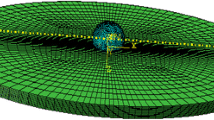Abstract
In this paper, numerical model based on continuum damage mechanics is presented to predict the damage behavior in quasi-isotropic composite laminates under low-velocity impact conditions. Hashin criterion and a gradual degradation scheme are employed to trigger the intra-laminar damage initiation and growth. Additionally, an interface cohesive element is incorporated in the model to predict the inter-laminar delamination damages. A user-defined subroutine VUMAT comprising these constitutive models of intra-laminar and inter-laminar damage is written in FORTRAN and implemented into explicit finite element package ABAQUS. Parametric analysis is performed on quasi-isotropic composite model with different impact energy levels to study the impact velocity–time, velocity–displacement, acceleration–time and acceleration–displacement curves of full and reduced models as well as the damage development of intra-laminar matrix cracking and inter-laminar delamination. Reasonable accord between the numerical simulations and experimental test indicates good prediction of impact damage behavior of the proposed model at low-velocity impact conditions.












Similar content being viewed by others
References
Bouvet C, Castanié B, Bizeul M, Barrau J-J (2009) Low velocity impact modelling in laminate composite panels with discrete interface elements. Int J Solids Struct 46:2809–2821
Bui Q (2011) A modified Benzeggagh-Kenane fracture criterion for mixed-mode delamination. J Compos Mater 45(4):389–413
Choi I-H, Kim I-G, Ahn S-M, Yeom C-H (2010) Analytical and experimental studies on the low-velocity impact response and damage of composite laminates under in-plane loads with structural damping effects. Compos Sci Technol 70:1513–1522
Feng D, Aymerich F (2014) Finite element modelling of damage induced by low-velocity impact on composite laminates. Compos Struct 108:161–171
Hosur MV, Adbullah M, Jeelani S (2005) Studies on the low-velocity impact response of woven hybrid composites. Compos Struct 67:253–262
Jang J, Sung M, Han S, Yu W-R (2017) Prediction of delamination of steel-polymer composites using cohesive zone model and peeling tests. Compos Struct 160:118–127
Khalili SMR, Soroush M, Davar A, Rahmani O (2011) Finite element modeling of low-velocity impact on laminated composite plates and cylindrical shells. Compos Struct 93:1363–1375
Kumar D, Roy R, Kweon J-H, Choi J-H (2016) Numerical modeling of combined matrix cracking and delamination in composite laminates using cohesive elements. Appl Compos Mater 23:397–419
Lachaud F, Espinosa C, Michel L, Rahme P, Piquet R (2015) Modelling strategies for simulating delamination and matrix cracking in composite laminates. Appl Compos Mater 22:377–403
Li X, Hallett SR, Wisnom MR (2008) Predicting the effect of through-thickness compressive stress on delamination using interface elements. Compos A Appl Sci Manuf 39:218–230
Liu P, Gu Z, Peng X, Zheng J (2015) Finite element analysis of the influence of cohesive law parameters on the multiple delamination behaviors of composites under compression. Compos Struct 131:975–986
Long S, Yao X, Zhang X (2015) Delamination prediction in composite laminates under low-velocity impact. Compos Struct 132:290–298
Lopes C, Camanho P, Gürdal Z, Maimí P, González E (2009a) Low-velocity impact damage on dispersed stacking sequence laminates. Part II: numerical simulations. Compos Sci Technol 69:937–947
Lopes C, Seresta O, Coquet Y, Gürdal Z, Camanho P, Thuis B (2009b) Low-velocity impact damage on dispersed stacking sequence laminates. Part I: experiments. Compos Sci Technol 69:926–936
May M (2015) Numerical evaluation of cohesive zone models for modeling impact induced delamination in composite materials. Compos Struct 133:16–21
Mitrevski T, Marshall IH, Thomson RS, Jones R (2006) Low-velocity impacts on preloaded GFRP specimens with various impactor shapes. Compos Struct 76:209–217
Olsson R (2001) Analytical prediction of large mass impact damage in composite laminates. Compos A Appl Sci Manuf 32:1207–1215
Sevkat E, Liaw B, Delale F (2013) Drop-weight impact response of hybrid composites impacted by impactor of various geometries. Mater Des 52:67–77
Shi Y, Soutis C (2016) Modelling transverse matrix cracking and splitting of cross-ply composite laminates under four point bending. Theoret Appl Fract Mech 83:73–81
Shi Y, Swait T, Soutis C (2012) Modelling damage evolution in composite laminates subjected to low velocity impact. Compos Struct 94:2902–2913
Shi Y, Pinna C, Soutis C (2014a) Modelling impact damage in composite laminates: a simulation of intra-and inter-laminar cracking. Compos Struct 114:10–19
Shi Y, Pinna C, Soutis C (2014b) Interface cohesive elements to model matrix crack evolution in composite laminates. Appl Compos Mater 21:57–70
Soliman EM, Sheyka MP, Taha MR (2012) Low-velocity impact of thin woven carbon fabric composites incorporating multi-walled carbon nanotubes. Int J Impact Eng 47:39–47
Xiao S, Chen P, Ye Q (2014) Prediction of damage area in laminated composite plates subjected to low velocity impact. Compos Sci Technol 98:51–56
Systèmes, S-D. ABAQUS/Explicit (2011a) Version 6.11-1. User Documentation Manuals
Systèmes, S-D. ABAQUS/Explicit (2011b) Version 6.11. User Manual. ABAQUS Inc, Providence, RI, USA
Zhang J, Zhang X (2015) An efficient approach for predicting low-velocity impact force and damage in composite laminates. Compos Struct 130:85–94
Zhang X, Bianchi F, Liu H (2012a) Predicting low-velocity impact damage in composites by a quasi-static load model with cohesive interface elements. Aeronaut J 116:1367–1381
Zhang X, Bianchi F, Liu H (2012b) Predicting low-velocity impact damage in composites by a quasi-static load model with cohesive interface elements. Aeronaut J 116:1367–1381
Zhang D, Sun Y, Chen L, Pan N (2013) A comparative study on low-velocity impact response of fabric composite laminates. Mater Des 50:750–756
Acknowledgements
The research is partially supported by the Innovative Foundation for Doctoral Candidate of Jiangsu Province, China (KYLX15_1049).
Author information
Authors and Affiliations
Corresponding author
Rights and permissions
About this article
Cite this article
Duodu, E.A., Gu, J., Ding, W. et al. Simulation of Composite Laminate with Cohesive Interface Elements Under Low-Velocity Impact Loading. Iran J Sci Technol Trans Mech Eng 43, 127–138 (2019). https://doi.org/10.1007/s40997-017-0119-8
Received:
Accepted:
Published:
Issue Date:
DOI: https://doi.org/10.1007/s40997-017-0119-8




